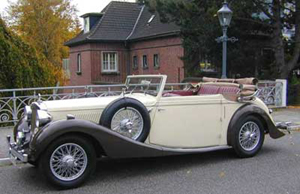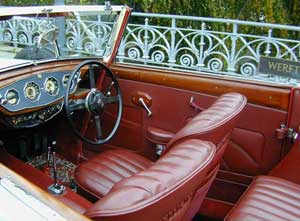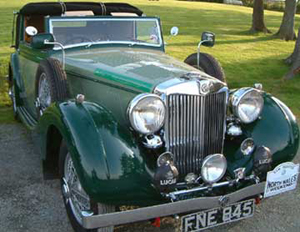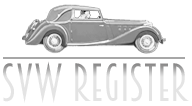
WA Tickford
Salmons and Sons was one of two companies that bodied MGs of the SVW range outside the factory. The other being Charlesworth. The Tickford bodies by Salmons and Sons were a three position drop head coupe. This is a fully enclosed design with roll up windows and full passenger protection. Very much a different concept than the factory saloon or Charlesworth tourers. Salmons and Sons of Newport Pagnell, Buckinghamshire, (the former grounds of the Tickford Abbey), were originally builders of horse drawn carriages then progressed into building very high specification quality bodies for motorized vehicles. By the late 1930’s the Tickford name was synonymous with a rage of extremely prestigious patented ‘Tickford’ convertible hoods.
From the scuttle forward, a WA Tickford looks identical to the saloon or tourer from the factory. Thus all coachwork aft scuttle was of Tickford design. The difference in design style from the saloon and tourers was significant. The lines of the Tickford body complemented and completed the WA front end very well. Where the saloon and tourers can appear slightly tall and boxed; the WA Tickford appears flowing and contiguous. The large doors and squared majestic hood flow to the rear of the body which ends with a splendid fall over the boot section. Underneath the bodywork was fitted a supporting frame to assist with rigidity. This was not fitted to the SA or VA Tickfords
Interior

WA Tickford – interior
The new style instrument panel of the WA, constructed of solid mahogany, continued in door cappings of the same wood and high polish standard. The doors are trimmed in leather with adjustable arm rests and neatly trimmed pockets. The Tickford, unlike the saloon and tourer was a 2 door car so silk door pulls were positioned to assist rear passengers to access. The front seats are of the bucket style seen in previous MG models, but are more supportive helping in the comfortable ride. The rear seats are noticeably higher than the front. When the hood is up the rear occupants are somewhat limited in view, but when down, the view and comfort in the rear seats is quite pleasant. Pull out ash trays, and a folding centre arm rest compliments the rear seats as well. The rake of the steering column places the large four spoke steering wheel nearly square to the driver. The tall doors meet the driver at nearly shoulder height. This combined with looking down the long horizontal bonnet through the narrow wind screen create a feeling of being in a very large car. The view to the rear for the driver is hindered at all times. With the hood up, the narrow rear view window allows little rearward vision, and with the hood down, the bulk of the hood material packs up as very little of the hood mechanism recesses into the body, thus blocking rearward vision.
MG logos appear throughout the interior, with octagon shape themes carried out in the instrument layout, ash trays, door handles, and such. Carpeting is throughout the interior and is of a high quality Wilton and detailed placement. Twenty three separate carpet pieces make up the compliment for the Tickford. Felt lined glove trays are symmetrically placed on either side of the wood dash fascia.
Exterior

WA Tickford – exterior
The hood mechanism for the Tickford is slow to operate by modern standards. It is best accomplished by two people, but can be done by one; however, several trips around the car are necessary. From the closed position, the hood is first moved to the cabriolet position. This is accomplished by pulling back the hood material, and then folding in the cant rails, then rolling the top material and securing it with two straps. From this point the folding mechanism is released by ‘breaking’ the pram irons from over-center. The hood then piles at the rear. All three positions are distinctive to the car and create a different look and feel to the driving experience.
The boot lid is designed to remain open and carry additional luggage, probably necessary as the boot section of the car is limited in space. The tools are also housed in the boot lid. Once loaded the lid is heavy to lift and operate. The body maintains a smooth and flowing appearance. Only the door hinges break up the flow of the sides of the body. The body lines are very neat and well maintained. Great difficulty and craftsmanship was necessary to allow such large doors to function well in an open car.
The spare is carried on the wing. This is a departure from the SA drophead in which the spare is carried at the rear. Some Tickfords left the factory with dual sidemount spares, which created a more formal appearance. The extra spare was a factory option available on all three models. At 5346 lbs, the WA Tickford is a large presence. The WA Tickford looks as massive as it truly is.
Driving impression
The WA Tickford is no sports car. Those that associate MG with light weight nimble cars will be disappointed if they seek the same from this MG. The WA Tickford pulls well, has precise control and handling, is very comfortable for the occupants, and generally feels quite solid on the road. It is however, a heavy car and so must deal with the characteristics that come with. The driving impression in one word would be majestic.
